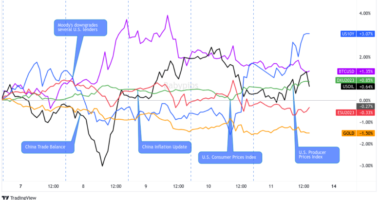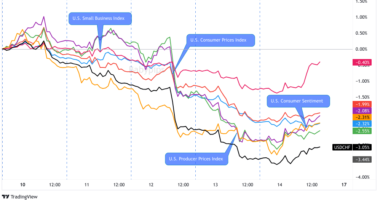
The markets are a dangerous place. Out of the blue, events can cause sudden and violent moves in the markets.
Unfortunately, we’ve all been on the wrong side of one of these. It seems very rare indeed that a surprise suits your market position.
Non-Farm Payroll data, GDP Numbers, interest rate changes, assassinations, terrorist attacks, extreme weather, profit warnings, resignations, bankruptcies, technology failures …
Here we look at the nature of shocks. How to survive – and even thrive – from the seemingly random.
Shocks and surprises – they’re not the same
Imagine you have a position in front of a Non-Farm Payroll release. You are living dangerously. You know that the release is often a big surprise.
It can be way off from economists’ estimates and the markets’ expectations. So, under your breath, you count down: 5 – 4 – 3 – 2 – 1.
Finally, the results land, the market spikes and within seconds reverses against the direction of the news and seems determined to stop out all longs and shorts. Does this sound familiar?
But hold on, the number was a shock, but it was not a surprise. We counted down to it.
NFPs are released (usually) on the first Friday of each month at 08:30 EST or 12:30 GMT. The release is as regular as clockwork each month. Hardly a surprise, but they are often way off consensus expectations and shock the market.
Non-Farm Payrolls and all of the * events listed above are not surprises, but they are often shocks. Only in a few cases above are the events both surprises and shocks.
The truly random event is very rare, so market shocks happen less often than most people imagine.
Nonetheless, shocks are rarely pleasant surprises. So, what trading strategies can you apply to avoid or even profit from market shocks?
Living peacefully
Many traders close their positions in front of “big” data releases. The advantage of this is you will never be adversely affected by an expected market shock.
But you are as vulnerable as anyone else to a random event. Moreover, the closing and re-opening of positions are costly, and you may have to re-enter at a terrible price level.
Putting up with it
Is there a way to stay in the market through the violence of data releases?
There is a way, but you need to have your Stop Loss far away from the market – beyond the expected price volatility range of the data releases.
The expected price volatility range at data releases is a measurable thing.
For example, take the hi-lo range of price movements in the 15 minutes following the release of the US GDP numbers.
Sometimes the data releases are in line, and the move is muted. Sometimes they surprise the market, and the price surges and falls.
So look at two things:
- The maximum range
- The average range
To be moderately conservative, place your Stop beyond the average post-release price swing. To be very conservative, beyond the largest price swing.
To do this, you will probably need to deleverage your position. This means reducing the exposure so you can have such a wide Stop. But unfortunately, this is the price you have to pay for ‘putting up with it.









